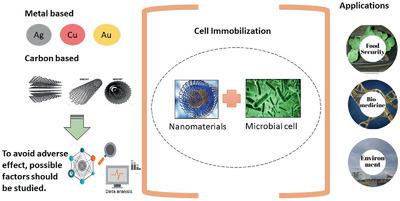当前位置:
X-MOL 学术
›
Biotechnol. Appl. Bioc.
›
论文详情
Our official English website, www.x-mol.net, welcomes your
feedback! (Note: you will need to create a separate account there.)
Emergence of nanomaterials as potential immobilization supports for whole cell biocatalysts and cell toxicity effects
Biotechnology and Applied Biochemistry ( IF 3.2 ) Pub Date : 2020-09-24 , DOI: 10.1002/bab.2034 Shoriya Aruni Abdul Manaf 1 , Siti Fatimah Zaharah Mohamad Fuzi 1 , Nor Hasmaliana Abdul Manas 2, 3 , Rosli Md Illias 2 , Kheng Oon Low 4 , Gurumurthy Hegde 5 , Rohaida Che Man 6 , Nur Izyan Wan Azelee 2, 3 , Hazel Monica Matias-Peralta 7
Biotechnology and Applied Biochemistry ( IF 3.2 ) Pub Date : 2020-09-24 , DOI: 10.1002/bab.2034 Shoriya Aruni Abdul Manaf 1 , Siti Fatimah Zaharah Mohamad Fuzi 1 , Nor Hasmaliana Abdul Manas 2, 3 , Rosli Md Illias 2 , Kheng Oon Low 4 , Gurumurthy Hegde 5 , Rohaida Che Man 6 , Nur Izyan Wan Azelee 2, 3 , Hazel Monica Matias-Peralta 7
Affiliation

|
The traditional approach of fermentation by a free cell system has limitations of low productivity and product separation that need to be addressed for production enhancement and cost effectiveness. One of potential methods to solve the problems is cell immobilization. Microbial cell immobilization allows more efficient up-scaling by reducing the nonproductive growth phase, improving product yield and simplifying product separation. Furthermore, the emergence of nanomaterials such as carbon nanotubes, graphene, and metal-based nanomaterials with excellent functional properties provides novel supports for cell immobilization. Nanomaterials have catalytic properties that can provide specific binding site with targeted cells. However, the toxicity of nanomaterials towards cells has hampered its application as it affects the biological system of the cells, which cannot be neglected in any way. This gray area in immobilization is an important concern that needs to be addressed and understood by researchers. This review paper discusses an overview of nanomaterials used for cell immobilization with special focus on its toxicological challenges and how by understanding physicochemical properties of nanomaterials could influence the toxicity and biocompatibility of the cells.
中文翻译:

纳米材料的出现作为全细胞生物催化剂和细胞毒性作用的潜在固定化支持
通过自由细胞系统进行发酵的传统方法具有生产率低和产品分离的局限性,需要解决这些问题以提高产量和成本效益。解决这些问题的一种潜在方法是细胞固定化。微生物细胞固定化通过减少非生产性生长期、提高产品产量和简化产品分离来实现更有效的放大。此外,碳纳米管、石墨烯和具有优异功能特性的金属基纳米材料等纳米材料的出现为细胞固定化提供了新的支持。纳米材料具有催化特性,可以提供与靶细胞的特异性结合位点。然而,纳米材料对细胞的毒性阻碍了其应用,因为它会影响细胞的生物系统,这一点不容忽视。固定化中的这个灰色区域是研究人员需要解决和理解的一个重要问题。这篇综述文章讨论了用于细胞固定化的纳米材料的概述,特别关注其毒理学挑战,以及通过了解纳米材料的物理化学性质如何影响细胞的毒性和生物相容性。
更新日期:2020-09-24
中文翻译:

纳米材料的出现作为全细胞生物催化剂和细胞毒性作用的潜在固定化支持
通过自由细胞系统进行发酵的传统方法具有生产率低和产品分离的局限性,需要解决这些问题以提高产量和成本效益。解决这些问题的一种潜在方法是细胞固定化。微生物细胞固定化通过减少非生产性生长期、提高产品产量和简化产品分离来实现更有效的放大。此外,碳纳米管、石墨烯和具有优异功能特性的金属基纳米材料等纳米材料的出现为细胞固定化提供了新的支持。纳米材料具有催化特性,可以提供与靶细胞的特异性结合位点。然而,纳米材料对细胞的毒性阻碍了其应用,因为它会影响细胞的生物系统,这一点不容忽视。固定化中的这个灰色区域是研究人员需要解决和理解的一个重要问题。这篇综述文章讨论了用于细胞固定化的纳米材料的概述,特别关注其毒理学挑战,以及通过了解纳米材料的物理化学性质如何影响细胞的毒性和生物相容性。









































 京公网安备 11010802027423号
京公网安备 11010802027423号